 |
A view of the Wesleyan chapel and the minister's house.
On the left is W. E. Cownley's haircutting and shaving
saloon which is still there today. The chapel, which
opened in 1810, had a large burial ground at the back, and
an adjoining school.
The photograph was taken in the early 1970s just before
the buildings disappeared. Demolition work had already begun
on the house.
Today it is the site of Wesleys Fold flats. |
| Another view of the derelict chapel taken a little
earlier. The building on the right is the Wesleyan Sunday
and Day School, originally one of the largest schools in the
town. In 1888 it catered for 238 children and 160 infants.
The school was erected in 1846 to the design of Mr. G.
W. Green and built by Mr. Thomas Adams at a cost of
£439.19s.6d. |
 |
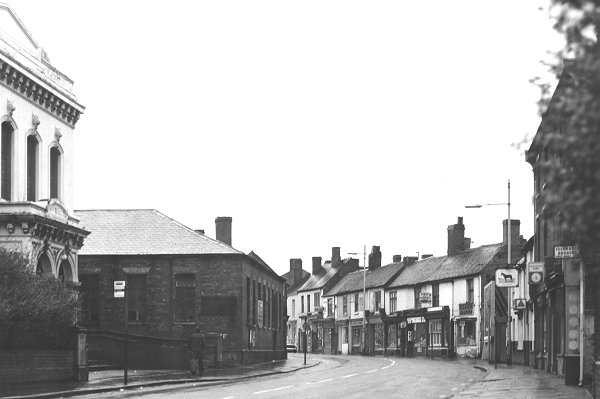 |
Another view of the chapel, the school, and the
once-familiar, and popular shops in Pinfold Street. On the
right is the Black Horse pub, frequented by the town's horse
racing fraternity.
The shop on the far right was owned by William Winn and had
the first electric lighting in the town. |
| A final view of the chapel, photographed as demolition
got underway. It had been enlarged in 1876-7, and had an
organ built by Abbott and Smith of Leeds at a cost £512.10s.
In 1907 the building was renovated, and electric lighting
replaced the old gas lamps.
After closure, the congregation moved to Slater Street,
and Great Croft Street Methodist chapels. |
 |
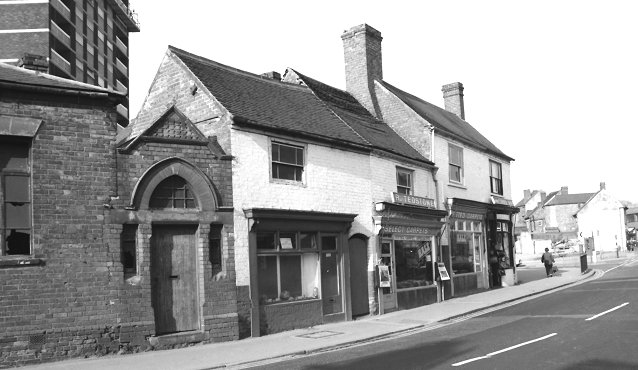
On the left is the Wesleyan school, and on the right
is Select Carpets run by Mr. R. Tedstone. Next right is Gladys's
Corner Shop that stocked household items and ornaments. |
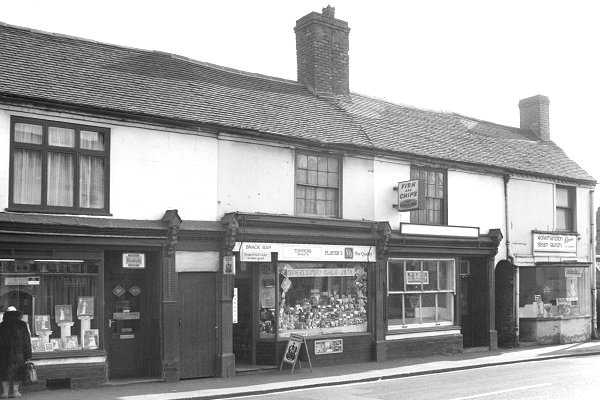 |
The shops on the other side of Pinfold Street look very
different today. In the early 1970s when the photograph
was taken, they were very popular and successful.
Many of the shopkeepers were household names, and well
respected members of the local community. |
| On the far right is a cleaners, belonging to
Wolverhampton Steam Laundry. The fish and chip shop next
door is run by W. and M. Smith. The shop in the centre,
called Toppers, had a snack bar and sold sweets, cigarettes,
and tobacco. It was a well-known and popular haunt for
teenagers in the 1960s. The shop on the left is occupied by
local photographer Len Bayley. For many years it was the
town's most successful photographic shop, often known as
Aston's, because from 1900 to 1940 it was run by the
well-known Darlaston photographer John Aston, under the name
of Aston's Studios. |
| Another well-known Darlaston shopkeeper was Len Mitchell
who had four shops in Pinfold Street. On the left is his
cycles and accessories shop which stocked items made by
Raleigh, Dawes, Hercules, and B.S.A. etc. On the right
is his pram ship which sold children's prams and toys. |
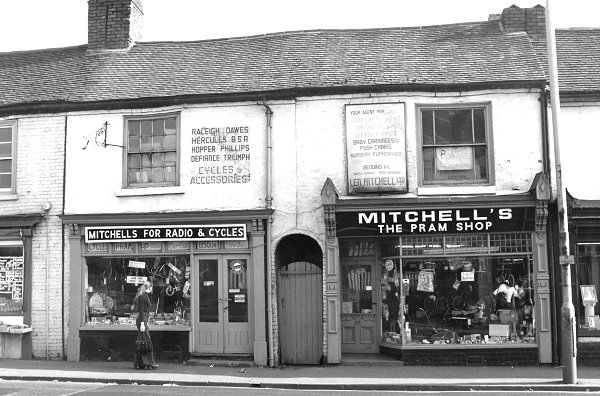 |
| Len Mitchell died in 1987 at the age of 88, and is still
fondly remembered. The shops closed in 1982 because of a
scheme announced by Walsall Council to extent St. Lawrence
Way through the shops to Darlaston Road. The scheme was soon
abandoned, and the buildings still survive today. |
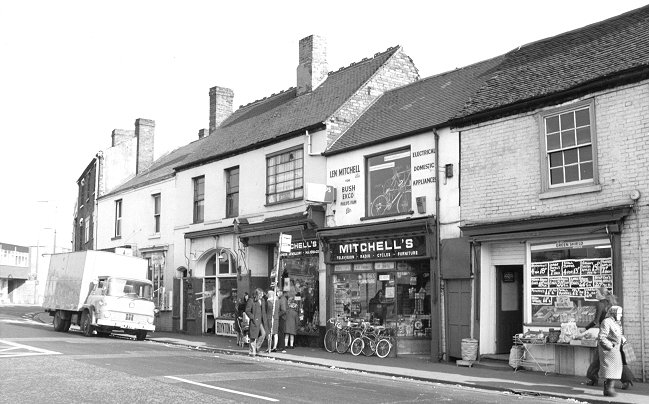
In the centre are Len Mitchell's other two shops. To the
left is his fashion and jewellery shop, and to the right
is his television, radio, and cycles shop, where he sold
and rented radios and TVs made by Bush, Murphy, Philips,
and Pam. On the left of Len's fashion and jewellery shop
is Boynton & Sons butchers, one of the best in the town. |

The eastern end of Pinfold Street looking towards The
Bull Stake and Walsall Road. On the left is the Mercia
Building Society that originally opened as the Darlaston
branch of the Wednesbury Building Society on 29th July,
1954. |
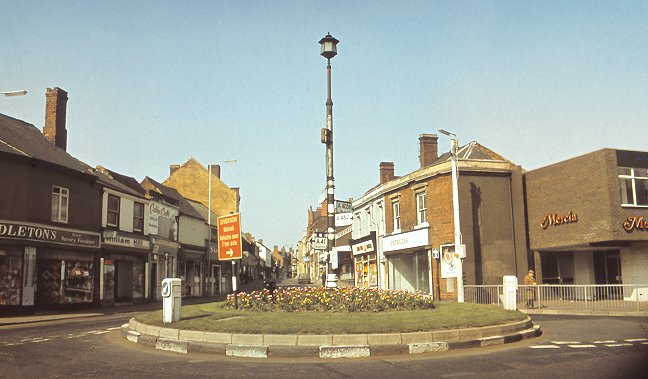
A colour view of the Bull Stake and King Street. On the
extreme left is Middleton's records and nursery
furniture shop. Middletons sold children's toys of all
kinds, prams, nursery furniture, and vinyl records. |
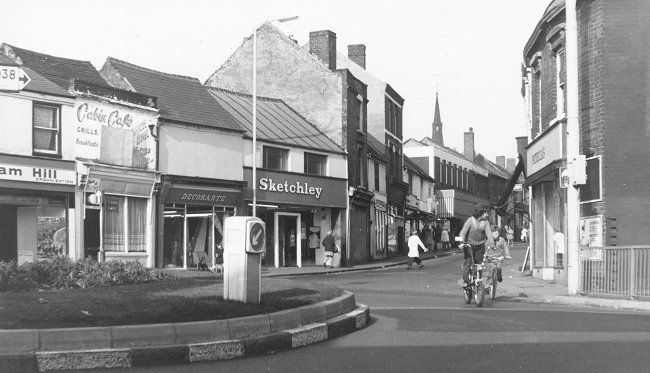
Another view of the Bull Stake and King Street. Across
the island on the left is William Hill's betting shop;
the Cabin Café, a popular meeting place for breakfast,
tea, coffee, hot pies, sandwiches, and snacks; Decorarte,
which specialised in curtains; and Sketchley's dry
cleaners. |
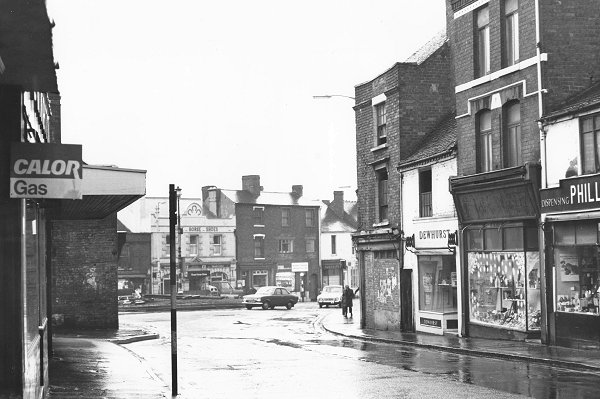 |
The view looking from the bottom of King Street towards
the Bull Stake. On the right where the library now stands
is an empty shop, next is Dewhurst's Butcher's shop,
then an
unnamed shop that sold picture frames, and ornaments, and on
the extreme right is Phillip's chemist shop. |
| During the demolition of Phillip's shop in January 1988,
an original 17th century timber-framed building was
discovered beneath the Victorian brickwork. |

Another view of the western side of King Street. On the
extreme left is the Hitachi TV-Radio shop, and Firkins
the bakers. Firkins had vacated the shop and moved
across the road in readiness for the demolition of the
older properties. Next door is Lipton's supermarket and
four doors along is Boots the chemist, which soon moved
across the road to its current location. |
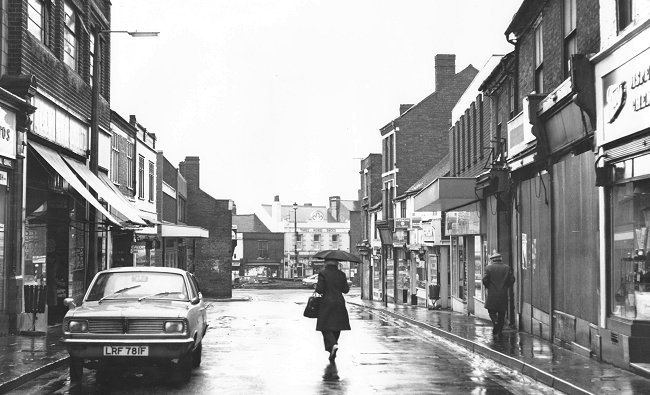
A final view of the lower end of King Street, taken on a
very wet day. On the left is the popular fruit and
vegetable shop, G. L. Bedworth & Sons Limited, at the
time the largest shop in the town. |
| Further up King Street on the eastern side
was J. Underwood's shoe shop. Underwoods were
well-known suppliers of high quality shoes.
On the right, past the two empty shops is Burtons the
gents' tailors, the best local place to go for a made to
measure suit. |
 |
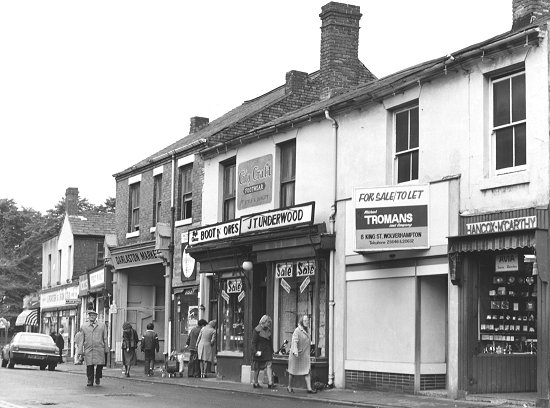 |
Another view of the eastern side of King Street. On the
right is Hancox & McCarthy's jewellers shop, with an empty
shop next door that was previously occupied by Stantons the
bakers. On the left of Underwoods is Darlaston Market,
previously Bakers ironmongers, then Percy W. Salt's butchers
shop; and Woods Radio, a television sale and rental shop. |
| On the opposite side of the street, on the corner of
High Street is a row of derelict shops. On the left is John Adey's butcher's shop
which moved to the opposite side of High Street, where it
was taken over by W. D. Jowett and Sons. Next door is R.
Lewis's animal food shop, which specialised in dog
food, bird food and fish food; then Boynton & Sons' butchers
shop; and J & K Butchers. |
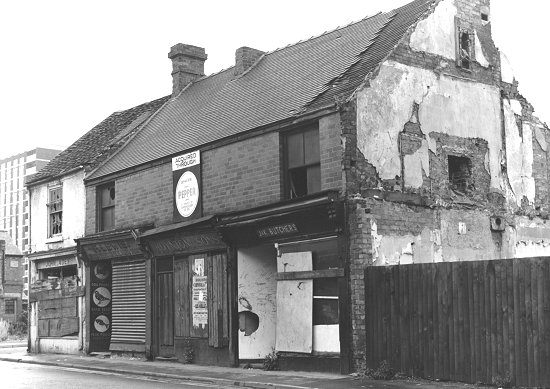 |
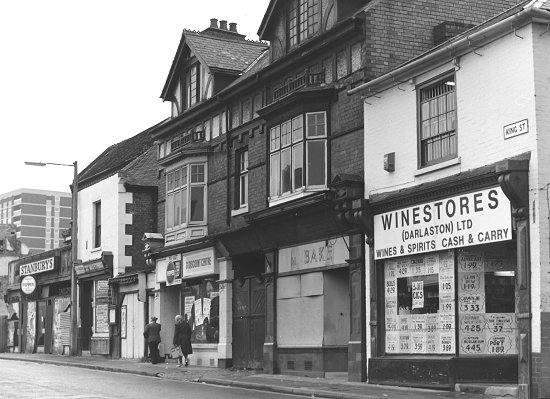 |
At the top of King Street on the left is Stanburys'
gents
outfitters and tailors, a very old and well-established
business. Next door is A. F. Parsons, a newsagent,
followed by two derelict shops, the Discount Centre, and M.
Bakers.
On the right is Winestores (Darlaston) Limited which sold
wines and spirits. |
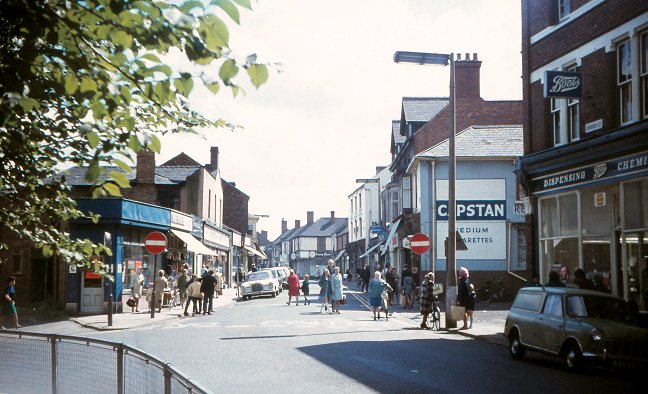
A final view of King Street, as seen from the end of Church Street.
| Looking into Victoria Road from Church Street. A view
that has hardly changed in forty years.
On the right is the wool shop, which is next door to Mary
Anne's general drapery shop.
In the centre is The Swan pub. |
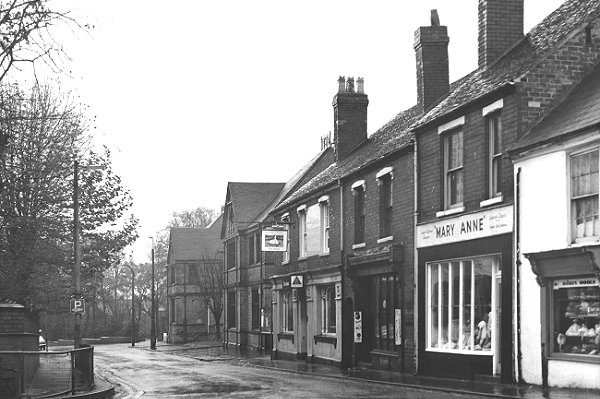 |
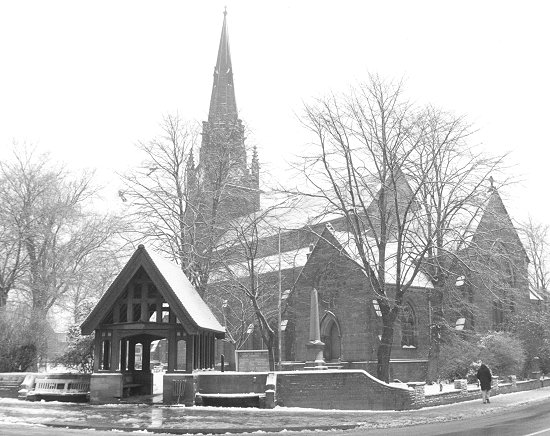 |
A winter view from the early 1970s of St. Lawrence's
Church. There has been a church on the site since the 12th
century. The original church, which was built of wood, had a
wooden tower until the early 17th century, when it was
rebuilt in stone.
Later in the 17th century, after a disastrous fire,
the church was rebuilt using salvaged material.
It was rebuilt again in 1807 in brick, in a plain style,
and rebuilt in stone in 1872. |
| The final version of the church appeared in 1905-7 with the
rebuilding of the spire, and the addition of a new clock, added at a cost
of £3,000. In 1931 a church hall was built at the western
end of the church. |
| The old electricity sub-station in Church Street built
by the M.E.C., the first company to widely distribute
electricity in the Black Country.
The building still survives, but much of the ornate
stonework has been removed. |
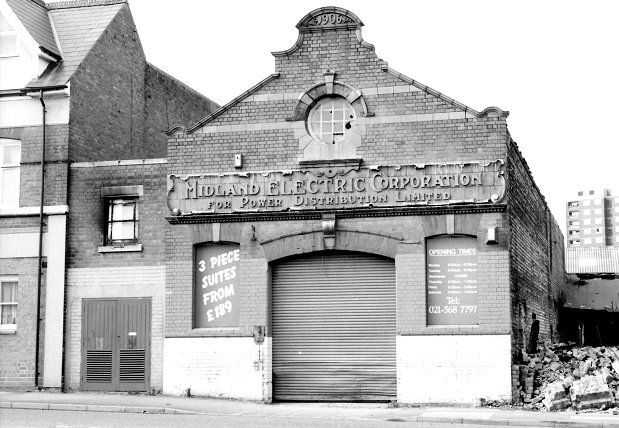 |
| When electricity came to Darlaston in the late 1890s it
was supplied by two companies; The Midland Electric
Corporation for Power Distribution Limited, in Church Street,
and The Blast Furnace Power Syndicate, which quickly
disappeared. In 1898 the M.E.C. was granted Provisional
Orders to supply a number of the local towns, including
Bilston, Brierley Hill, Cradley Heath, Darlaston,
Kingswinford, Old Hill, Tipton, Wednesbury and Willenhall.
The first company to get Statutory powers to distribute
electricity over such a large and varied area. A power
station was built on 14 acres of land at Ocker Hill to
supply the power. It stood near to a coal mine, and by the side
of the Birmingham Canal. Sub-stations were built
at Bilston, Brierley Hill, Darlaston, Old Hill, Tipton and
Wednesbury. Some local councils including Tipton and
Wednesbury decided to distribute the power themselves,
whereas others left it to the Corporation. |
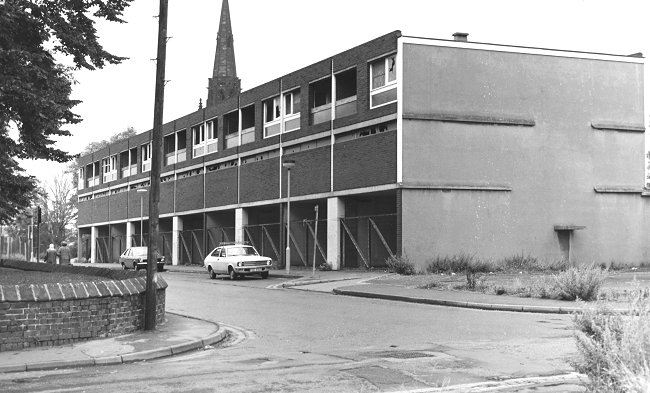
Darlaston's 'folly' in New Road. In an attempt to extend Darlaston
's shopping area the local authority built a row of shops in New
Road. Unfortunately the plans used by the builders had been copied
back to front, and the building itself was built back to front. The
building remained empty until the early 1970s, when it was
demolished
to make way for the original ASDA supermarket. |

Derelict shops in High Street in the early 1970s, just
before the whole area was redeveloped for the building
of the ASDA store. On the left is The Spinning Wheel, a
craft and model shop, next is Fine Footwear Repairs;
then the Darlaston Council's local shop, the Bull's Head
pub; a clothes shop; and Jowett's fruit and vegetable
shop. |
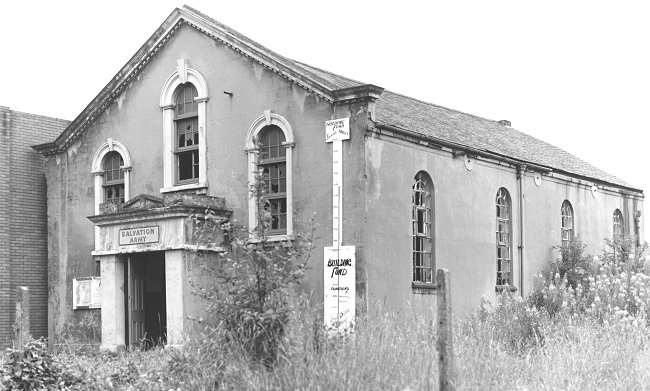
The Salvation Army Citadel in High Street, built by the
Darlaston Salvation Army Corps, founded in 1882 by two lady
officers, Captain Nellie Moore and Lieutenant Agnes Reynolds. The
building, originally known as the Temperance Hall, and later the
Salvation Army Barracks, was demolished in the early 1970s.
|
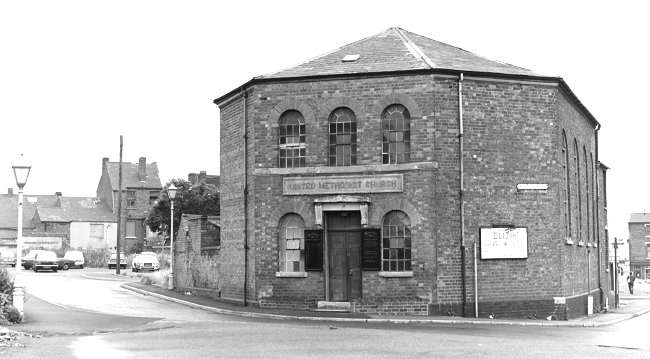
The United Methodist Church that stood in Great Croft
Street. Built in 1852, it could accommodate 500
worshippers, and survived until the early 1970s when the
whole area was redeveloped. |
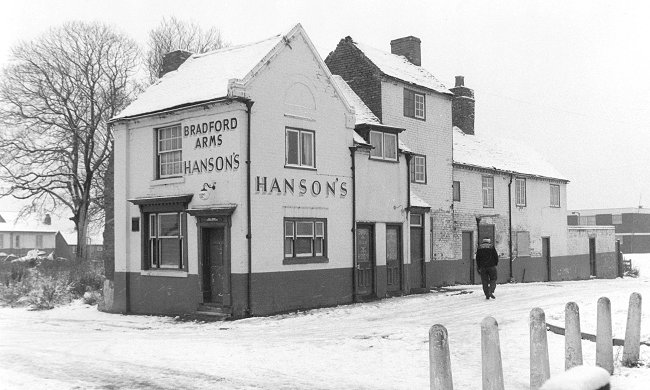
The Bradford Arms, known locally as "The Frying Pan"
because it was home to the Frying Pan Club. The club met
on Sunday nights, when each member had to bring along
their badge, shaped like a frying pan. If anyone forgot
to do so they had to pay a fine. A password had to be
known, and any member caught lighting their own
cigarette, or lifting their glass of beer with their
right hand, also had to pay a fine. The money raised
from the fines went to local charities. A different
chairman was elected each week, the symbol of his office
being a top hat and chain, with a pendant in the shape
of a frying pan. |
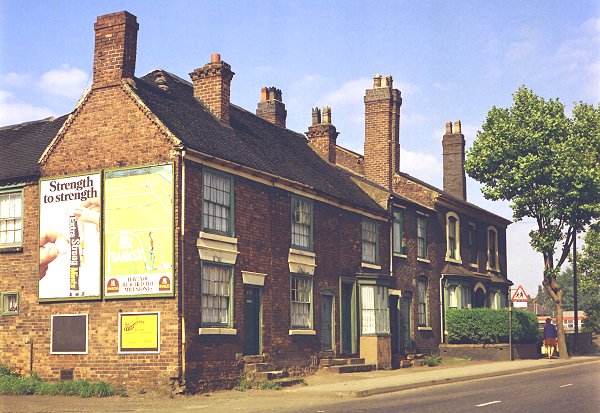 |
An interesting row of houses that stood by the canal in
Moxley Road. It is likely that they were built by the canal
company. Some, if not all, must have housed company
employees. Behind the first three houses was a
stable for the horses that pulled the boats along the
canal. |
|
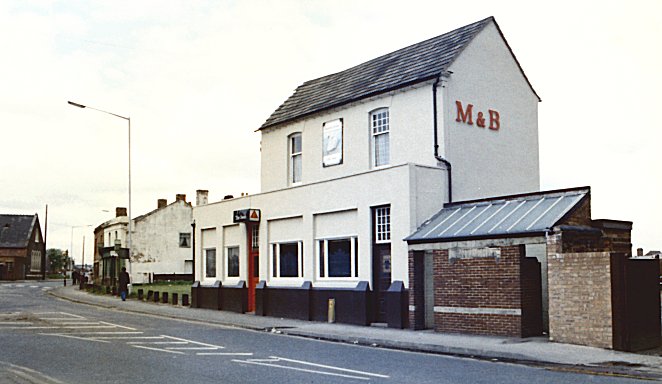
The Swan pub that stood on the opposite side of the
canal in Moxley Road. |

The old Darlaston Nut and Bolt works on the corner of
Cemetery Road and Kendricks Road, known locally as
"Bogie Wilkes". It received its nickname because the
factory was a very dark and scary place, and people used
to say 'beware of the bogieman', a frightening imaginary
being.
Darlaston's factories prospered after the coming of
the railway. The Grand Junction Railway, the world's
first long-distance steam-powered railway line, that ran
from a junction with the Liverpool and Manchester
Railway, to Birmingham, passed alongside the factory.
It's importance can be seen from the factory's original
name, the Grand Junction Works. |

A Black Country Sunset. In the distance is the furnace
belonging to Bradley & Foster Limited, at Darlaston Iron
Works. |
 |
|
 |
|
Return to the
previous page |
|
Proceed to
Wolverhampton |
|
|